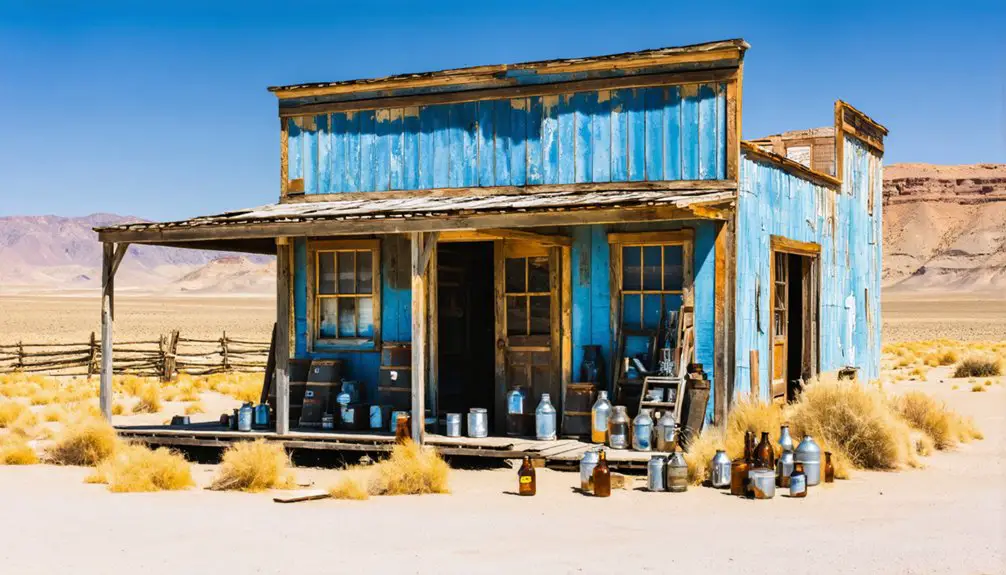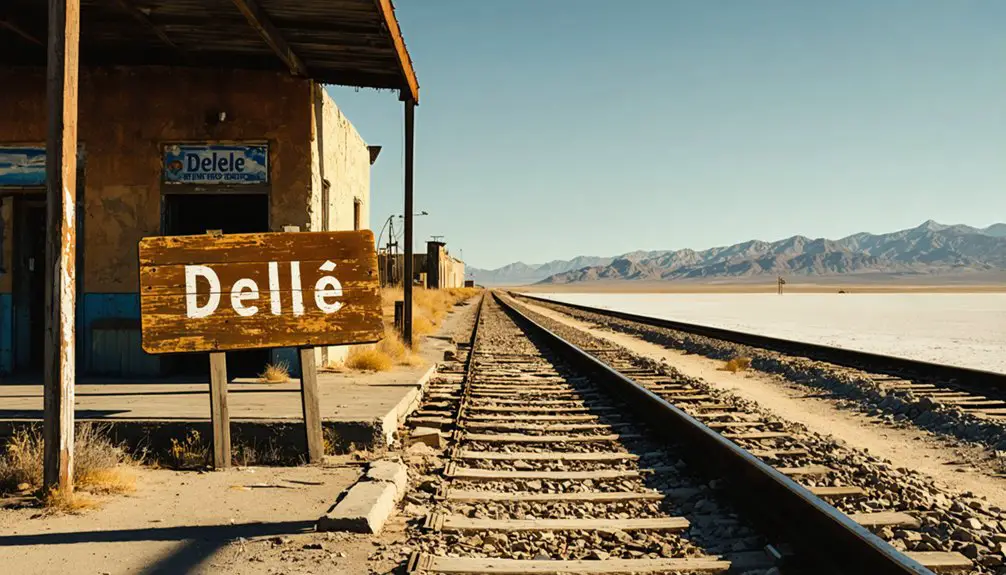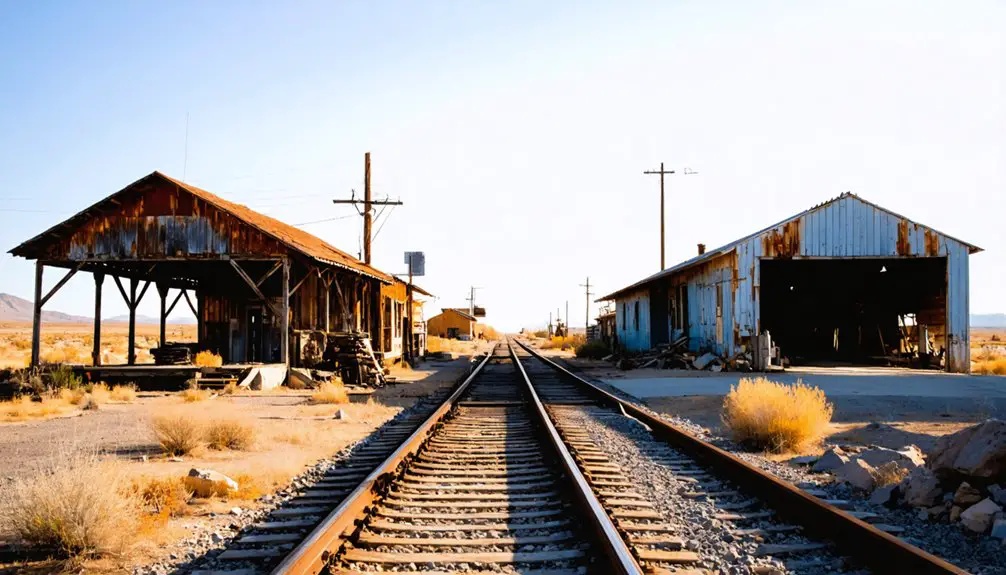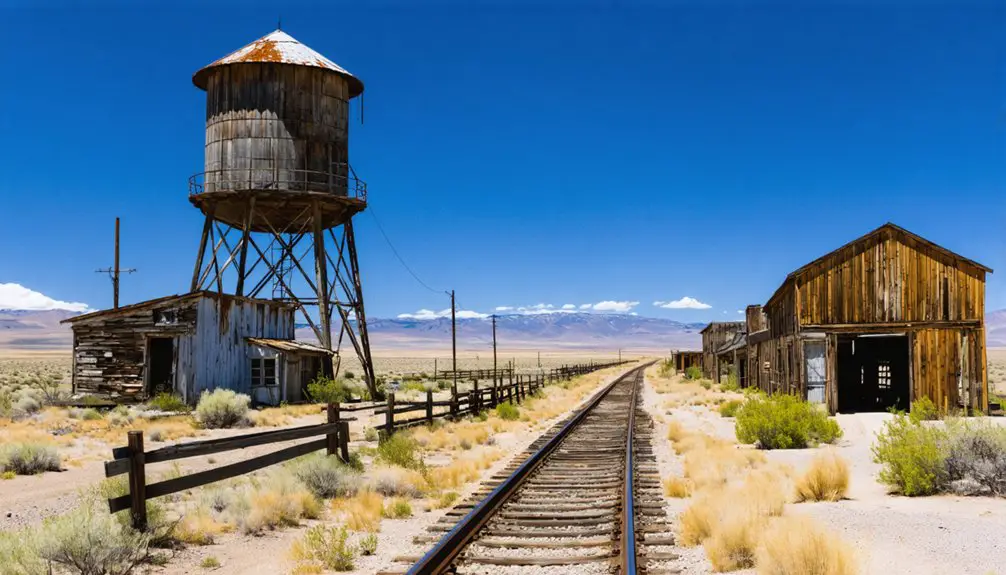You’ll find Delle, Utah along I-80 between Salt Lake City and Wendover, where it began as a Western Pacific Railroad water depot in 1880. Originally named “Dalles Spring,” officials shortened it to “Delle” for telegraphic efficiency. The town peaked at 174 residents in 1950, housing Irish, Scottish, and Greek immigrant workers who maintained the railroad’s operations. When diesel engines replaced steam locomotives, Delle’s decline began, leaving behind scattered foundations and a weathered water tower that tell a deeper story.
Key Takeaways
- Delle was established in 1880 as a railroad water depot, serving steam locomotives crossing the Great Salt Lake Desert.
- The ghost town’s population peaked at 174 residents in 1950, including Irish, Scottish, and Greek immigrant railroad workers.
- Delle’s decline began when diesel engines replaced steam locomotives, eventually leading to the closure of postal services.
- Remnants include cement foundations, an old water tower, and scattered ruins from former railroad facilities and immigrant housing.
- The site now serves as a destination for ghost town explorers, offering views of architectural remains against Utah’s salt flats.
From Bustling Railroad Stop to Desert Solitude
As steam locomotives chugged across the Utah desert in 1880, the Western Pacific Railroad established Delle as a crucial water depot for trains preparing to cross the vast salt flats.
Originally named Dalles Spring, the town derived its name from a French word meaning water.
You’d have found a bustling community of railroad workers drawing water from springs up to 12 miles away, maintaining the essential infrastructure that kept the trains moving west.
The town’s population, including Irish, Scottish, and Greek immigrant families, peaked at 174 residents in 1950.
But when diesel engines replaced steam locomotives, you wouldn’t need those water stops anymore.
Like many abandoned railroad towns across Utah, Delle’s fate paralleled that of Promontory after the rerouting of major rail lines.
Now, if you’re into railroad nostalgia or ghost town exploration, you’ll discover only the abandoned water tower and scattered foundations, silent witnesses to Delle’s transformation from an indispensable railroad hub to a haunting desert solitude.
The Story Behind Delle’s Unique Name
The water-rich springs of Utah’s desert led to the town’s original French name “Dalles Spring,” meaning “water” – a fitting choice for a settlement that relied heavily on nearby water sources.
In Utah’s arid landscape, water-blessed springs inspired the name Dalles Spring, reflecting the life-giving resource that sustained early settlement.
Through strategic water resource management, the town transported water via pipeline from Delle Ranch, 12 miles away, to support steam locomotives and settlers.
As railroad communication strategies evolved, Western Pacific Railroad officials decided to streamline the name for telegraphic efficiency.
They shortened “Dalles Spring” to simply “Delle,” making it faster to transmit messages along the line.
While the town’s water-focused French name reflected early European exploration, the simplified version suited the practical needs of railroad operations.
Even after the town’s decline, this unique name endures as a symbol of its railroad heritage.
Like many post office closures in ghost towns across Utah, Delle’s discontinuation of postal services marked a significant milestone in its population decline.
Unlike many cow towns in Utah, Delle’s history was shaped more by railroad development than cattle ranching.
Life Along the Western Pacific Railroad
Western Pacific Railroad’s arrival in 1906 transformed Utah’s desert landscape, bringing new life to remote areas like Delle.
You’d have found railroad workers and their families establishing a tight-knit community, centered around the essential maintenance and service operations along the line.
The railroad economy flourished as trains carried copper ore, minerals, and agricultural products between Salt Lake City and Nevada. The construction effort employed 600 men working simultaneously on extensive grade sections stretching into the Great Salt Lake Desert.
You could see the impressive engineering feats nearby, including tunnels through mountain passes and tracks crossing vast salt beds. The challenging terrain required constructing 43 tunnels throughout the railroad system.
Community dynamics revolved entirely around the railroad’s needs, with Delle serving as a significant waypoint for crews traversing the salt desert.
Local merchants and workers benefited from increased commerce and employment opportunities, while shippers enjoyed competitive freight rates thanks to this alternative transcontinental route.
Water Station Legacy and Railroad Operations
You’ll find Delle’s origins deeply rooted in its essential role as a water station, established in 1880 to support steam locomotives crossing the unforgiving Great Salt Lake Desert.
The station’s sophisticated water infrastructure transported fresh water from springs up to 12 miles away, including the crucial Delle Ranch source on Skull Valley’s east bench. The area thrived during its peak productivity years from the 1920s through the 1940s. The development of this station began in 1871 as part of broader efforts to improve regional transportation.
Your understanding of early railroad operations wouldn’t be complete without knowing how this water depot, with its tower and reservoir system, enabled steam engines to make the challenging journey between Salt Lake City and Wendover.
Steam Engine Supply Hub
Established in 1880, Delle served as an essential water station for steam engines traversing the harsh Great Salt Lake Desert salt flats. Originally named Dalles Spring, this Western Pacific Railroad village managed complex steam logistics through an extensive water sourcing system that transported water from springs up to 12 miles away. Similar to the region’s early pioneers who faced survival challenges in Utah’s arid landscape, the town’s water infrastructure proved vital for maintaining rail operations across the desert. Located ten miles east of Low, the settlement was perfectly positioned to serve as a maintenance hub.
You’ll find Delle’s remarkable operational setup included:
- A sophisticated reservoir and water tower system designed specifically for steam locomotive refilling
- Strategic placement between Wendover and Salt Lake City to support long-haul train routes
- Specialized infrastructure drawing water from multiple mountain springs through an engineered pipe network
The settlement’s critical role in water management made it indispensable for railroad operations until diesel engines eventually replaced steam power, marking the end of an era.
Desert Water Infrastructure
Despite the harsh desert environment, Delle’s water infrastructure represented a marvel of early 20th-century engineering, designed to meet both railroad and settlement needs.
You’ll find that water supply stations were strategically positioned every 15-20 miles along the rail line, equipped with specialized tanks and pressurized systems for rapid locomotive refilling.
The reservoir design incorporated innovative solutions to overcome challenging geological conditions. Engineers constructed dams and impoundments in nearby canyons to capture seasonal runoff and springs, while earthfill structures maximized local materials.
Water stations served as crucial maintenance points, supporting not just steam engines but also the domestic needs of desert residents.
When diesel locomotives eventually replaced steam engines, many of these sophisticated water facilities became obsolete, leaving behind remnants of Delle’s pioneering water management system.
Immigration and Early Settlement Stories

When the Western Pacific Railroad established Delle in 1880, the remote Utah settlement quickly attracted immigrant workers from Ireland, Scotland, and Greece seeking employment opportunities.
You’ll find their immigrant experiences revolved around maintaining essential railroad infrastructure while living in company-owned housing.
These hardworking settlers adapted to frontier life through:
- Working at water depots and fueling stations for steam engines
- Living in modest company homes, often using scrip at the company store
- Maintaining their cultural identities while blending with American industrial life
The immigrant population peaked between 1920-1940, with 174 residents recorded in 1950.
Delle’s immigrant railroad community reached its zenith in the interwar years before declining to 174 residents by mid-century.
Unlike other Utah settlements that drew Mormon converts, Delle’s immigrant community consisted primarily of railroad laborers and their families, whose cultural adaptations shaped this isolated desert town‘s character.
The Rise and Fall of a Desert Community
You’ll find Delle’s story mirrors many desert railroad towns, where steam engines once stopped for essential water drawn from springs up to 12 miles away.
During its peak between 1920-1940, the town prospered with a stable community of railroad workers, mainly Irish, Scottish, and Greek immigrants who maintained the water facilities and track operations.
The shift to diesel engines in the mid-20th century, followed by the construction of I-80, eliminated Delle’s primary purpose as a water stop and led to its eventual abandonment.
Railroad Era Prosperity
As steam locomotives chugged across the Great Salt Lake Desert in 1880, the Western Pacific Railroad established Delle as an essential water depot for their operations.
Originally named “Dalles Spring,” this railroad innovation transformed the desert landscape into a thriving community of Irish, Scottish, and Greek immigrants.
The town’s community dynamics centered around three key elements:
- A sophisticated water system sourcing springs from 12 miles away
- Housing developments for railroad workers and their families
- Essential infrastructure including a water tower and reservoir
Desert Isolation Effects
Though Delle’s remote desert location initially served its purpose as a railroad water stop, the harsh isolation of Utah’s Great Salt Lake Desert ultimately shaped the town’s destiny.
You’ll find the desert ecology played an essential role in limiting the community’s growth, with water sourced from springs up to 12 miles away through lengthy pipelines. Despite their resilience, immigrant railroad families never grew beyond 174 residents at their peak in 1950.
The town’s community resilience was tested by its geographic constraints. You can trace how the desert isolation restricted economic diversification, leaving residents vulnerable when railroad operations ceased.
While the harsh environment preserved many abandoned structures, it also accelerated infrastructure decay. Today, the remote setting that once defined Delle’s purpose now draws occasional visitors seeking ghost town adventures and motocross excitement.

Reaching the Bonneville Salt Flats requires a straightforward drive from Wendover, Utah along Interstate 80. You’ll find the salt flats access at exit 4, marked as Bonneville Speedway. From there, head north on Bonneville Speedway Road where you’ll encounter a Y-junction after 1.5 miles.
For a successful visit to this vast salt-crusted landscape, follow these key steps:
- Take the right fork at the Y-junction and continue 3.9 miles to reach the flats.
- Park at the road’s terminus, where you’re free to explore the expansive white terrain.
- Check weather conditions before your trip, as rain can create mirror-like pools or affect accessibility.
You won’t find many amenities at the flats themselves, so stock up on supplies in Wendover, where you’ll also find the closest gas and food options.
Architectural Remains and Historic Structures
While steam locomotives still ruled the rails in 1880, Delle emerged as a vital water depot along the Western Pacific line, featuring an extensive water infrastructure that would shape the town’s destiny.
You’ll find historical remnants of the town’s heyday, including cement foundations from railroad facilities and traces of housing that once sheltered 174 residents, many of Irish, Scottish, and Greek descent.
As you explore the site today, you’ll witness the architectural decay of Delle’s evolution from railroad village to highway stop.
The 1950s brought a motel and gas station south of Interstate 80, while earlier structures deteriorated.
What remains now includes non-native trees along the tracks, old sheep pens on eastern hillsides, and fragments of the water system that once supplied both locomotives and residents.
Cultural Heritage of Railroad Workers

As immigrant laborers flocked to western railroad towns in the early 1900s, Delle became home to a vibrant community of Irish, Scottish, and Greek railroad workers who shaped the town’s cultural identity.
Living in company-provided housing, these immigrant families formed tight-knit communities centered around the railroad’s operations.
Their cultural traditions influenced daily life in three significant ways:
- Workers maintained close social bonds through shared heritage
- Families preserved their homeland customs while adapting to desert life
- Cultural practices helped them cope with harsh working conditions
You’ll find their legacy preserved in Delle’s remaining structures, which tell the story of resilient railroad workers who maintained critical infrastructure despite extreme weather and isolation.
The town stands as a tribute to the immigrant communities that were essential to America’s western railroad expansion.
Modern Adventures in an Abandoned Landscape
Today, adventurous travelers can explore Delle’s haunting remnants along Interstate 80 near Utah’s Bonneville Salt Flats.
You’ll find cement foundations, weathered water towers, and mysterious railroad infrastructure scattered across the arid landscape, making it a prime destination for ghost town exploration and adventure photography.
When you visit, you’ll need to prepare carefully – there aren’t any modern amenities in this remote setting.
The non-native trees planted during the railroad era still stand as silent sentinels, while abandoned structures create striking contrasts against the stark salt flats.
You can wander among the cement walls and forgotten reservoirs, imagining the bustling railroad stop that once served steam engines.
The site’s isolation and raw desert environment offer you an authentic off-the-beaten-path experience in a truly untamed landscape.
Frequently Asked Questions
Are There Any Supernatural or Paranormal Stories Associated With Delle?
You won’t find documented ghost sightings or haunted locations in Delle. Unlike other Utah ghost towns with rich paranormal histories, there’s no verified evidence of supernatural activity in this former railroad stop.
What Wildlife Species Can Commonly Be Found Around Delle Today?
Ever wonder what roams Utah’s wild spaces? You’ll spot elk, mule deer, and moose in Delle’s wildlife habitats, plus mountain lions and black bears. Native species like pronghorn antelope and bighorn sheep frequent nearby areas.
Has Any Movie or Television Production Ever Filmed in Delle?
You won’t find documented film history or production locations in this town – available records and databases show no evidence of movies or TV shows ever filming there.
What’s the Closest Modern Town With Permanent Residents to Delle?
You’ll find Wendover just 25 miles west along I-80, offering local attractions like casinos and fuel stops, while historically significant Tooele lies 30-40 miles southeast with more extensive amenities.
Are There Any Active Preservation Efforts to Protect Delle’s Remaining Structures?
You won’t find any active preservation efforts for Delle’s structures today. Despite its historical significance as a railroad stop, preservation challenges like ownership issues and deteriorating conditions have prevented formal protection initiatives.
References
- https://jacobbarlow.com/2018/08/16/delle-utah/
- https://jacobbarlow.com/2019/08/02/photos-of-abandoned-delle-utah/
- https://www.youtube.com/watch?v=AuIj2U_st1k
- https://exploreutah.wixsite.com/utah/delle-utah
- https://kids.kiddle.co/Delle
- https://exhibits.lib.utah.edu/s/ghost-towns/page/railroad-towns
- https://www.youtube.com/watch?v=y4kszONpP3A
- https://historytogo.utah.gov/tag/ghost-town/
- https://www.familysearch.org/en/wiki/Utah_Ghost_Towns
- https://en.wikipedia.org/wiki/List_of_ghost_towns_in_Utah



